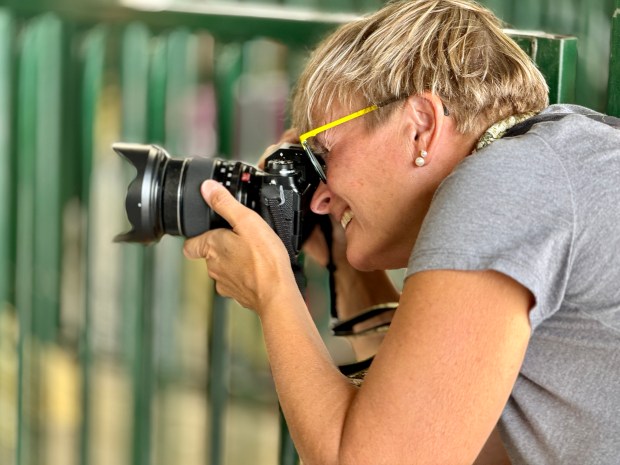Dust Bowl-era images inspired Valparaiso University photography professor Aimee Tomasek to document the lives of Porter County 4-H participants in a long-term project.
How long-term? Tomasek has been doing this for about 13 years and plans to keep doing it as long as she can.
“I have been, for 13 years, following the same set of kids,” photographing them with their 4-H projects at the fair, she said.
But her photography involvement with the kids goes back further than that. She was a volunteer trolley driver for the fair and would walk the fairgrounds during her breaks. “Wow, this is a wonderful community,” she realized.
In 2020, the fair wasn’t held because of the COVID-19 pandemic. She arranged to create portraits of the kids and their projects at the fairgrounds, one at a time, so they would still have their work documented even without the fair going on.
“You get your animals in January, you’ve got to raise them,” she said. With the photographs, the children were able to get their work recognized.
“They’re just straight-up portraits,” Tomasek said. “I titled that series Un-Fair Portraits.”
Since then, she has begun photographing more and more of the kids and their various projects. It’s a labor of love.
“I have photographed the kids in their gardens,” Tomasek said. “I photograph whatever they want me to photograph.”
Projects go far beyond livestock, everything from woodworking to cake decorating to sewing to beekeeping.
“Some of that is really hard to photograph,” Tomasek said. “It’s really quite flattering that they want to share their things with me.”
Tomasek can trace her affinity for photography back to her 4-H days in small-town Wisconsin. She picked up a camera for the first time at 9 years old. For all 10 years of 4-H, she entered photography, rabbits and beekeeping projects – the honey, not the bees – in her county fair.
“I still am really fascinated by bees,” she said. One of her portraits is of Porter County 4-H’s beekeeping superintendent harvesting honey.
She’s also fascinated by documentary photographs from the Dust Bowl era in the Library of Congress. The images are available online.
She ran across photographs by Arthur Rothstein that intrigued her. “He also made a significant body of work at county fairs in Kansas,” Tomasek said.
“I’m a documentary photographer,” she explained. Often, that type of image is considered disturbing or tragic, showing the aftermath of events such as blizzards, tornadoes or major crimes. But they also document everyday life.
“I end up shooting the same thing every year with consistency,” she said. Along the way, she sees the children grow, and not just vertically.
“What has changed is the willingness and energy of 4-H’ers,” Tomasek said. “They’ve opened the doors for me.”
“It’s a lot more personally intimate because they’re sharing some personal moments with me,” she said.
Because the photos are of minors, she isn’t putting the images online for the public to view. She shares the annual albums, 3,000 to 4,000 images, with fellow Fair Board members, parents and 4-H superintendents. Parents can download images of their own children.
“I live here. These are my neighbors,” she said.
Kellie Pozil of Morgan Township, one of the parents, is impressed with Tomasek. “Aimee finds the magic in the moment. Even if you don’t think there’s magic there, she pulls it out,” Pozil said.
Pozil’s mother, Cindy Boo, is Porter County 4-H’s goat superintendent. “They don’t butt, they don’t eat tin cans,” she said.
“Aimee can make a most horrible picture look interesting,” Boo said.
Kellie’s children, Ava and Lexi Pozil, likewise appreciate Tomasek’s skill. “She even tries to get my hamsters in the photos,” Ava, a sixth-grader, said.
Doug Ross is a freelance reporter for the Post-Tribune.



